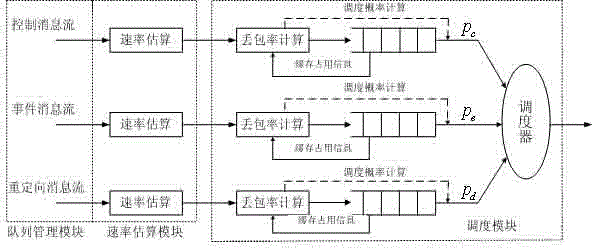Bandwidth allocation method of forwarding and control element separation (ForCES) transmission mapping layer based on stream control transmission protocol (SCTP)
A bandwidth allocation method and transmission mapping technology, which are applied in the bandwidth allocation field of the ForCES transmission mapping layer, and can solve problems such as occupying bandwidth and starving low-priority channels.
- Summary
- Abstract
- Description
- Claims
- Application Information
AI Technical Summary
Problems solved by technology
Method used
Image
Examples
Embodiment Construction
[0053] The present invention will be further described below in conjunction with accompanying drawing.
[0054] The SCTP-based ForCES transmission mapping layer bandwidth allocation method ensures the transmission of control messages through active queue management and dynamic probability priority scheduling based on rate and buffer control, while fully utilizing the total network bandwidth resources.
[0055] The bandwidth allocation method of the ForCES transmission mapping layer based on SCTP comprises the following steps:
[0056] Step (1). Such as figure 1 As shown, the ForCES interface that transmits ForCES protocol messages is further divided into the protocol layer (PL) and the transport mapping layer (TML). The types of ForCES protocol messages can be divided into three categories: control messages, event messages, and redirection messages.
[0057] Firstly, a message queue is established for each of the three different message flows of control messages, event mess...
PUM
 Login to View More
Login to View More Abstract
Description
Claims
Application Information
 Login to View More
Login to View More - R&D
- Intellectual Property
- Life Sciences
- Materials
- Tech Scout
- Unparalleled Data Quality
- Higher Quality Content
- 60% Fewer Hallucinations
Browse by: Latest US Patents, China's latest patents, Technical Efficacy Thesaurus, Application Domain, Technology Topic, Popular Technical Reports.
© 2025 PatSnap. All rights reserved.Legal|Privacy policy|Modern Slavery Act Transparency Statement|Sitemap|About US| Contact US: help@patsnap.com



